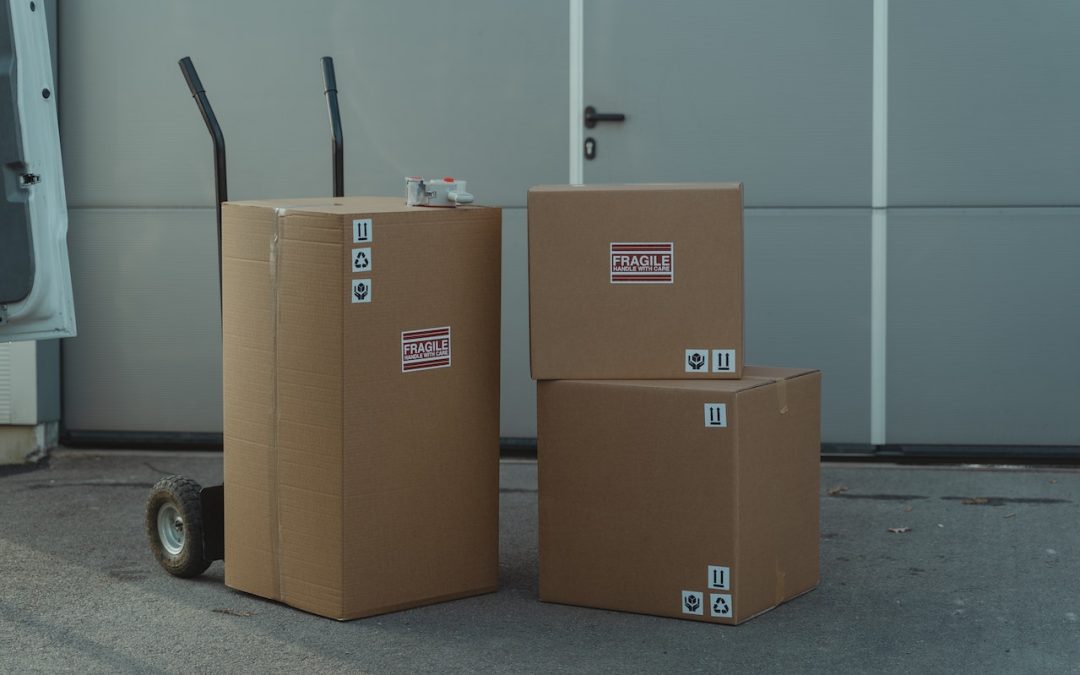正しく発送するには、商品の発送準備が非常に重要です。
貨物はかなりの距離を移動し、何度も持ち手や輸送手段を変更する可能性があるため、損傷のリスクを避けるために適切な梱包が必要です。
しかし、商品を梱包する最良の方法は何でしょうか?
パッケージの選択
商品の外側を固定し、保護するために、さまざまな種類の梱包材が使用されます。
主要なパッケージンググループとその長所と短所を見てみましょう。
段ボール – メリット
古き良き段ボール箱。 それがリストのトップになるとは思わなかったでしょう?
段ボールは、その頑丈で軽量な性質のおかげで、輸送物を保護するために何十年も使用されてきました。 剛性があるため積み重ねが簡単で、リサイクル可能であることを考慮すると、確かに環境に優しい選択肢です。
段ボール – 短所
ダンボールは乾いているときは非常に丈夫ですが、濡れているときはどうでしょうか? それほど多くはありません。 段ボールの大きな欠点は、雨天に対する耐久性です。 また、思ったよりも重い重量に耐えることができますが、大きくて重い荷物には適していません。
段ボールは、幾何学的な形状に適しているため、ぎこちない形状の商品を適切に扱うのも困難です。
木製ケース – メリット
木製ケースは非常に丈夫で損傷しにくいため、運送業界で人気が高まっています。 そのため、貴重でデリケートな積荷品の第一の選択肢となっています。
木材は素材として本来強度があり、ダンボール箱と同様に積み重ねが容易で、他のケースを重ねても十分な強度を持っています。
段ボール箱とは異なり、木製ケースは暴風雨に対してはるかに信頼性が高くなります。
木製ケース – 短所
このタイプのパッケージの唯一の欠点は、それに伴う価格です。
単純なことですが、木材はボール紙よりも高価で、より多くの加工が必要です。しかし、シャワーを浴びてもびしょ濡れにならない、より強力な製品にお金を払っていることを忘れないでください。
木箱 – メリット
私たちはあなたが何を考えているか知っています。 クレートってケースと同じじゃないの?
クレートはケースに似ていますが、同じではありません。 木箱も木製で、こちらも 4 つの硬い側面と 1 つの床を備えています。ただし、上部もあります。
木箱は、大きな貴重品だけでなく、ガラス製品や電子機器などの壊れやすい品物にも最適で、種類によって目的も異なります。 フレーム木箱は重い物の収納に適しており、開いた木箱は空気を循環させて生鮮食品の換気を保ち、密閉した木箱は輸送中の安全性を高めます。
輸送中の損傷のリスクを避けるために、木箱は容量いっぱいに詰める必要があり、商品がガタガタするのを防ぐために隙間を埋める必要があります。 大量の商品を収納でき、完全に密閉されているため、貨物にとって安全なオプションです。
木箱 – 短所
木箱は大きいです。 収納できる容量が膨大なため、より多くの保管スペースを必要とします。 これは、積み降ろしに本格的な機械が必要であることも意味します。また、機械は非常に重いため、貨物の重量に影響し、運賃が高くなる可能性があります。
パレット – メリット
誰もがパレットを見たことがあるでしょう。 これらは道路貨物輸送で最も一般的に使用されており、箱というよりも木製のプラットフォームに近いものです。
パレットは木箱よりも木材の使用量が少ないため、はるかに安価です。 また、使用しないときは、後で再利用するために簡単に保管できます。
サポートしている商品が正しく梱包されている限り、貨物のパレット積みは確実な梱包方法です。 この方法は堅牢かつシンプルで、フォークリフトでの積み降ろしや移動が簡単です。
パレットはほとんどの種類の貨物に使用できますが…
パレット – 短所
パレットは壊れやすい荷物には適していません。 これは、商品が同封されていないためです。 四方、または上部から彼らを守るものは何もありません。
パレットを使用して商品を梱包する場合は、荷物が乾いた状態に保たれるようにする方法も考慮する必要があります。 パレットに積まれた商品を耐候性にするには、追加の梱包材が必要です。
コンテナ – 長所
コンテナはコールテン鋼で作られた大きな金属製の箱です。 これらは安全な梱包の最高級品です。
コールテン鋼は耐食性があり、信じられないほど強いです。 商品を発送するコンテナを選択するということは、十分なスペースを確保し、船からトラックへ簡単に移動できる、安全性の高い梱包方法を選択することになります。
さらに良いことは? コンテナに入れればほとんど何でも輸送できます。 電子機器、貴重品、食品、扱いにくい重い荷物など、何でも構いません。
コンテナ – 短所
満杯でも半分空でも、コンテナを目的地に届けるには同じ配送料を支払う必要があります。 これは、商品をコンテナの全容積を必要としない多くの運送会社にとって大きな障害となっていますが、LCL 輸送はオプションとなりえます。詳細については、こちらを。
コンテナ輸送のもう 1 つの大きな欠点は、コンテナの調達です。 新型コロナウイルス感染症(COVID-19)のパンデミックによる進行中の影響から季節的な品不足に至るまで、適切な場所に十分なコンテナがない場合があり、それがサプライチェーン全体に影響を与える重大な遅延を引き起こす可能性があります。
梱包材はどうするの?
パッキンや詰め物は、商品が傷つかないように緩衝するために使用されます。 これを業界用語でダンネージと呼び、衝撃吸収材として機能するだけでなく、輸送中の湿気を吸収するのにも役立ちます。 適切な梱包で損傷を防ぐことで、商品を新品の状態に保ちます。 ダンネージがなければ、商品が売れなくなったり、状態が悪くなり返品される可能性があります。
ダンネージには 3 つのタイプがあり、商品に最も適したものを選択する必要があります。 それぞれ見てみましょう。
ソリッドダンネージ
重量物にはソリッドダンネージを使用します。
木材
木製の頑丈なダンネージは、重くて丈夫な商品の周囲にフレームを作成し、輸送中に互いに衝突する可能性のある複数の商品間の障壁を維持します。
木材は再生可能であるため、環境に配慮した良心を持つ荷主にアピールし、簡単に入手できるため、梱包の深刻な危機に陥ることはありません…しかし、悪いニュースはありますか?
一部の国ではそれが許可されていません。
また、一部の国では輸入に関税がかかります。
鋼鉄
スチールは非常に高価な梱包オプションであり、この理由から、または重い商品と軽い商品の間に非常に強力な障壁が必要な場合に、一般に高価な商品に使用されます。
プラスチック
他のタイプとは異なり、固体プラスチックの梱包は商品を擦り傷から保護するのに最適です。 強度があり、あらゆる容器にフィットするさまざまな形状に成形できます。 このため、プラスチック製の梱包は、ぎこちない形状の製品に最適です。
堅固なプラスチック梱包はかなり高価ですが、高価な貨物の場合は投資する価値があります。
ソフトダンネージ
小型軽量の商品を発送する場合は、通常、柔らかいダンネージ素材が使用されます。
発泡スチレン
以前はピーナッツや発泡スチロールのボールを梱包するのが一般的でしたが、地球に悪影響を与えるため、最近ではあまり使用されなくなりました。 商品と外箱の間の隙間を埋める働きをします。 成形発泡スチロールは、高価な商品や形状が複雑な商品に適したカスタマイズ可能なオプションです。
プチプチ
ああ、古き良きバブルラップ。 柔軟で安価なバブルラップは、非常に簡単で何度も再利用できるため、最も一般的に使用される梱包材です。 泡が弾けない程度に。
空気枕は新しい発明ですが、同じ前提に基づいています。 これらの素材はどちらも配送コストにあまり影響せず、保管も簡単です。
木のチップ
木材チップは 100% リサイクル可能で、安価に入手できます。 湿気に対処する必要があり、導電性がないため劇的な温度変化による危険がない場合に最適です。
紙ベースのダンネージ
この種のダンネージ材は軽量品にも使用されます。
細断紙
シュレッダー紙は安価で再利用可能でリサイクル可能です。 このタイプのダンネージは、外箱内の商品に非常に柔らかいクッションを提供するため、壊れやすいものの発送に最もよく使用されます。
段ボール
紙と同様に、段ボールも購入して細断して同様に使用できます。 段ボールを薄いシートに切断して箱にパッドを入れ、中の商品を保護することもできます。 強度と柔軟性を兼ね備えているので、作業性に優れています。
適切なパッケージの選択…
輸送中の安全を確保するには、商品ごとに異なるコンテナが必要です。
生鮮食品
商品を冷蔵または冷凍しておく必要がある場合は、腐敗を防ぐためにしっかりとしたコールドチェーンが設置されていることを確認する必要があります。 選択する梱包は湿気に耐える必要があり、生の果物や野菜などの一部の商品では空気が循環できる必要があります。 クレートはこれに適しています。
生鮮食品の発送について詳しくは、最近のブログをご覧ください。
高額商品
高価な商品には、最良の状態を保つための強力な梱包が必要です。 高価な商品が破損して到着した場合、誰も扱いたくありません。 スチールおよび固体プラスチックのパッキンは非常に頑丈であり、プラスチックは特に摩耗を防ぐため、最も効果的です。
大型商品
大きいってどういう意味ですか? 大きな貴重品は木箱でも保護できますが、商品の特性に合わせた適切な梱包とコンテナを組み合わせた方がよいでしょう。 重い大型商品の場合は、スチール製のバリアとプラスチック製の梱包を選択しますが、軽量で大型の商品の場合は、十分な気泡緩衝材で十分です。
貨物のラベル付け
梱包したら、商品には適切なラベルが必要です。 商品が異なれば、その内容と輸送先によって、要件も異なります。 危険品、生鮮品、壊れやすい品物にはすべてその旨ラベルを付ける必要があり、遅延や拒否を避けるために、輸出入先の国の規則や規制を確認することが賢明です。
適切な梱包は長期的には時間とお金を節約します
適切な梱包と準備は、輸送中に貨物を保護し、販売可能な状態に保つのに役立ちます。
今後の発送にどのような梱包を使用すればよいかわかりませんか? 輸出先の国の規則や規制に関する情報を見つけるのに苦労していますか? ミレニアムに電話してください。 私たちのフレンドリーなチームは知識の泉です。

